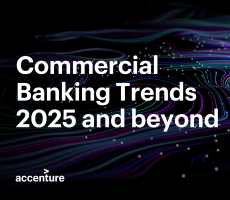Commercial banking is at a strategic inflection point. As we look ahead to the next five years and beyond, the question is no longer how to keep pace with change—but how to lead it. Commercial banks have the potential to achieve accelerated growth, even amidst geopolitical and economic uncertainties. Success in this dynamic landscape will require rethinking of how banks go to market and create value — for clients, employees, and shareholders alike.

View the summary of our Commercial Banking Trends for 2025 and beyond.
Learn MoreThe pressure is on to deliver personalized services at scale, modernize infrastructure, navigate complex regulations, and uncover new growth opportunities. This is particularly intense in corporate and small to medium-sized business (SMB) segments, where client expectations are higher than ever, margins are tight, and competition from disruptors is fierce.
The good news? Leading banks are already stepping up to the challenge. They’re rearchitecting their operating models, integrating artificial intelligence (AI) to boost productivity, simplifying technology stacks, and accelerating innovation through partnerships and managed services. By acting with focus and urgency today, these banks will not only navigate the challenges but also shape the future of commercial banking leadership by 2030.
In this blog, we’ll dive into the top trends that we expect to shape commercial banking. Following our Banking Top 10 Trends 2025 report we are not just stopping at 2025; we’re looking ahead to the bank of 2030. To envision this future, we’ve drawn our insights from working with over a hundred commercial banks worldwide and from conversations with banking leaders across the globe. We are grateful for the collective input and hope that it sparks a spirit of innovation and conversation within your organization.
The trends shaping commercial banking in 2025 and beyond
The following trends represent what we expect to shape commercial banking and what commercial banks should consider now to stay ahead and build a resilient enterprise for the future.
 Powering the front-office with AI
Powering the front-office with AI
After years of significant investment in SaaS-led transformation programs that built foundational sales platforms, many banks are still waiting to see a full return on investment. Rather than making additional foundational investments, banks are now focused on activating the value of what’s already in place — by simplifying the employee experience, introducing value-adding tools and upskilling teams to use AI as a productivity partner.
 Lending innovation with agentic AI
Lending innovation with agentic AI
Banks are deploying capital to pursue gen AI experiments to improve loan origination and underwriting, in some cases building on their recently implemented SaaS-based LOS platforms. The real differentiator will be turning AI pilots into production. Industry leaders will move to scale AI in commercial lending—accelerating underwriting, enhancing portfolio insights, and driving a distinct competitive advantage.
 Transaction banking: a new growth engine
Transaction banking: a new growth engine
Banks are repositioning transaction banking around growth opportunities—reimagining onboarding, servicing, and value-added solutions across payments, cash management, trade finance, and treasury services. Transaction banking is evolving into an embedded, real-time solutions integrated directly into clients’ daily workflows. With tools like cash flow forecasting, analytics driven insights, and automated treasury functions, banks are positioning themselves not just as transaction processors, but as indispensable operating partners.
 Risk management as a competitive differentiator
Risk management as a competitive differentiator
With rising fraud, sophisticated cyber threats, and mounting regulatory scrutiny, managing risk and compliance is no longer just about protection—it’s about enabling responsible growth through loan and portfolio monitoring, dynamic scenario simulation, and smarter stress testing. While quick wins may lead to more scalable and efficient operations, the real value of these AI-native capabilities lies in improving balance sheet management and enabling growth opportunities in a competitive and increasingly volatile market.
 Beyond cost takeout: Operations as a means to modernize
Beyond cost takeout: Operations as a means to modernize
Rising pressure on operating margins is pushing commercial banks from tactical expense cuts to strategic cost transformation. Banks are increasingly turning to their managed services partners to streamline non-differentiating functions, reducing complexity, accelerating deployment, and allowing internal teams to focus on high-value areas. This is not just about efficiency; it is about accelerating capabilities, with speed to scale providing enhanced customer experience and business flexibility.
 Market consolidation through M&A
Market consolidation through M&A
Macroeconomic pressures, geopolitical tailwinds in North America and rising competition will drive market consolidation, as banks seek to grow their client bases and expand product offerings. The commercial banking line of business represents valuable assets that will pique the interest of acquirers. Most banks will focus on consolidation, but some will selectively accelerate acquisitions of fintechs—particularly in commercial banking, lending and embedded finance. This will allow them to enhance digital capabilities and diversify revenue streams to meet rising customer expectations.
 The SMB growth renaissance
The SMB growth renaissance
Banks are refocusing on the small and medium business (SMB) sector, recognizing it as a strategic source of stable deposits and scalable, tech-driven lending growth. Advances in digital engagement models allow banks to serve this high-volume segment efficiently and profitably. At the same time, automated underwriting and real-time credit decisioning are making it faster and more cost-effective to extend capital to SMBs. In 2025, banks will stop using a combination of retail and scaled-down commercial banking capabilities to serve SMBs. Instead, they will start building AI-enabled, personalized, and sector-specific offerings to pursue growth.
To learn more about these trends we expect to shape our industry, download the summary here. If you’d like to discuss these trends, please contact either of us: Humad or Rishi.
We’d like to thank our colleagues, Maurits Olijve and Christopher Jaggard, for their contributions. Maurits leads commercial banking in EMEA, and Christopher leads in Asia Pacific. Both are happy to discuss these trends further.
In addition, if you’re planning to attend this year’s nCino nSight2025 in Charlotte, please make sure to connect with our experts. We will have a booth and will host a session on agentic AI in commercial lending and origination. We hope to continue the conversation.











